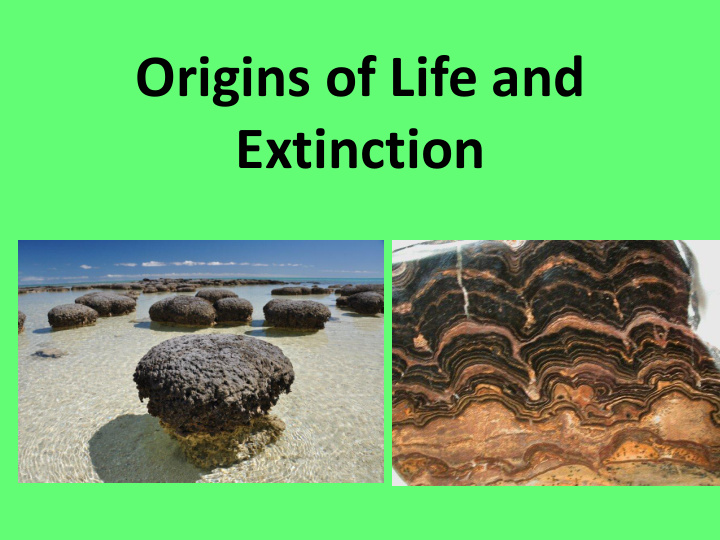



Origins of Life and Extinction
What is evolution?
What is evolution? • The change in the genetic makeup of a population over time • Evolution accounts for the diversity of life on Earth • Natural selection is the major driving mechanism of evolution
Evidence for Evolution • Charles Darwin used evidence to develop his theory of evolution by natural selection • Examples? • Today?
Evidence of Biological Evolution • Geographic – Distribution of living things • Geological – Fossils • Physical – Comparative Morphology/Embryology • Chemical – DNA nucleotide and protein sequences • Mathematical – Molecular Clocks or Radiometric Dating of Fossils
Scientific evidence supports various models of the natural origin of life on Earth. 1.D.1 (a)
When did Earth form? Earliest life forms?
Origin of Life on Earth • Oparin’s Hypothesis • Primordial Soup Model (J.B.S. Haldene) • Urey-Miller Experiment • RNA World Hypothesis • Theory of Endosymbiosis
Oparin’s Hypothesis • Proposed that early life formed through a series of reactions that made simple compounds gradually into more complex organic molecules • Catalyzed by UV radiation and lightening • 3.9 to 3.5 billion years ago
Primordial Soup Model (Haldane) • Primitive Earth provided inorganic precursors (such as H 2 O, CO 2 , NH 3 ) from which organic molecules could be synthesized • Inorganic precursors served as monomers for the formation of complex organic molecules • Monomers produced polymers with the ability to replicate, store and transmit information
Primordial Soup Model
Urey-Miller Experiment • 1953 - Chemical experiment that showed it was possible to form complex organic molecules from inorganic molecules in the absence of life
RNA World Hypothesis • Proposes that RNA could have been the earliest genetic material, rather than DNA • Supported by the discovery of ribozymes • Ribozymes are capable of self-replication
Evolution of Early Life Organic Molecules Protocells Nonphotosynthetic Prokaryotes Photosynthetic Prokaryotes Unicellular Eukaryotes Multicellular Eukaryotes
Theory of Endosymbiosis • Describes how cells ingested other cells and became dependent on one another for survival ( symbiosis ), resulting in a permanent relationship • Prokaryotes to eukaryotes
Geological evidence provides support for models of the origin of life on Earth. 1.D.2 (a)
Formation of Earth • Earth formed approximately 4.6 billion years ago • Environment was too hostile for life until approximately 3.9 bya • Fossil evidence for life dates to 3.7 bya – stromatolites (fossilized microbial mats of primarily cyanobacteria)
Fossil Evidence of Early Life
Geological Evidence of Atmospheric Oxygen • Free O 2 dissolved in surrounding water, eventually reacting with dissolved iron • Produces iron oxides which accumulate in sediments
Oxygen Revolution (2.5 to 2.7 bya)
Single-Celled Eukaryotes • Oldest fossils of eukaryotes are about 2.1 billion years old • Evidence for endosymbiosis ?
Multicellular Eukaryotes • Oldest known fossils are of small algae from 1.2 billion years ago • Animals during the Cambrian Explosion (535- 525 mya) – Cnidarians, Porifera, Mollusca • Colonization of land around 500 mya – fungi, plants, and animals • Earliest fossil tetrapods – 365 mya Choanoflagellates
Tetrapods • Tetrapods (four limbs) evolved from lobe- finned fish • “ Tiktaalik ” – transitional fossil of fish to first tetrapods (375 mya)
Continental Drift • What is continental drift? • How does continental drift contribute to evolution?
Continental Drift • Reshapes physical features of the planet • Alters habitats in which organisms live • Causes changes in climate • Promotes allopatric speciation by interrupting gene flow
Evidence for Continental Drift
Species extinction rates are rapid at times of ecological stress. 1.C.1(b)
Five Major Extinctions • Ecological stress?
Five Major Extinctions • Ordovician-Silurian – wiped out 85% sea life, blamed on an ice age • Late Devonian – wiped out 75% of ALL species, asteroids, climate change, new plants • Permian – “Great Dying”, 96% of ALL species, enormous volcanic eruptions ( flood basalt ), warmed Earth by 6°C, drop in oxygen levels
Five Major Extinctions • Triassic-Jurassic – wiped out 50% of ALL live, blamed on climate change, asteroids, plants were not as affected as animals • Cretaceous-Tertiary (K/T) – death of the dinosaurs, evidence of asteroid impact
Extinction and Evolution • Mass extinctions alter ecological communities • Fossil record indicates that within 5-10 million years, diversity of life recovers to previous years • Why?
Human Impact on Ecosystems and Species Extinction Rates • 6 th mass extinction • How are humans modifying the global environment?
Recommend
More recommend